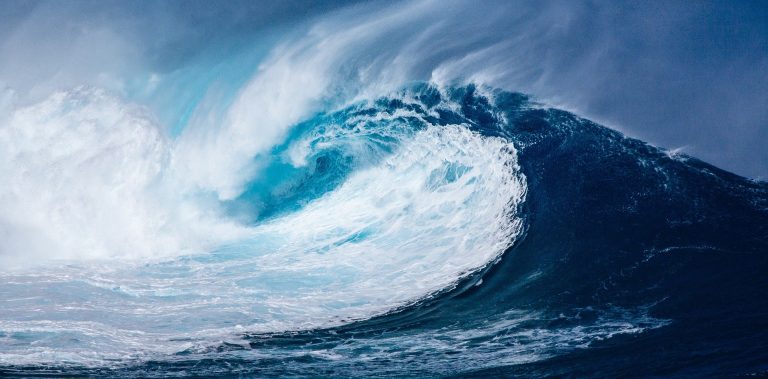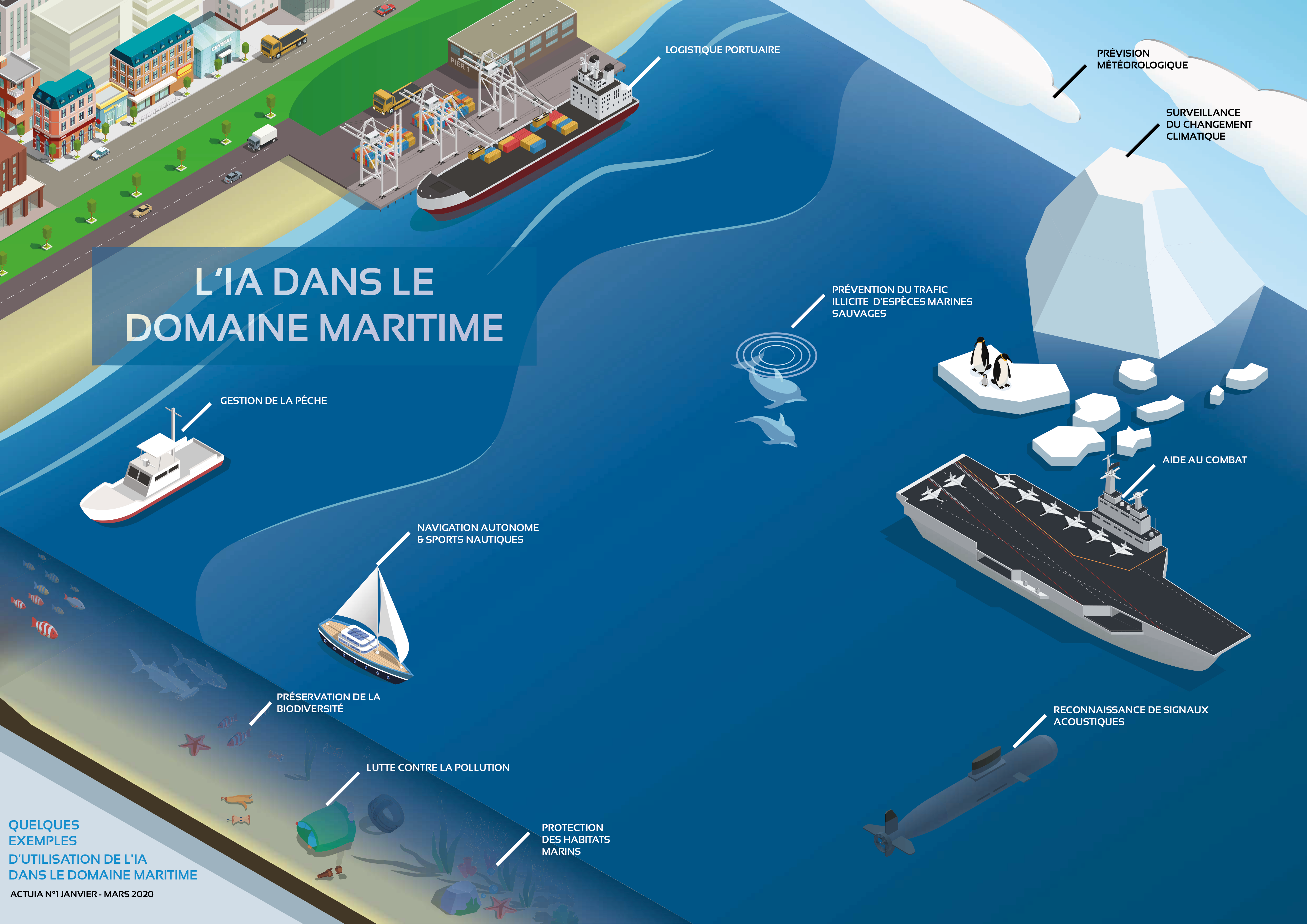
Artificial intelligence is everywhere, including where the general public may not expect it. The maritime field is an excellent example. There are innumerable cases of AI use: optimisation of port logistics, species preservation, autonomous navigation and environmental protection.

Ocean data, collection, analysis and processing
Marine data collection has increased considerably in recent years, in particular through the deployment of sensors, radars, sonars, ROV (Remotely Operated Vehicle) and AUV (Autonomous Underwater Vehicle) underwater robots and maritime UAVs.
Applications are already integrated in maritime transport, military defence, fisheries management and seabed exploitation, research following crashes at sea, surveillance and improved weather forecasting. But it is also in the protection of the environment and the fight against climate change that machine learning technologies can be used to respond to one of the major challenges facing the planet.
Companies, public authorities and NGOs are building databases on which to work on deploying solutions. For example, the Ocean Data Alliance proposes to develop an open source data platform. This will make it possible to use the learning machine for the development of monitoring and prediction tools in various fields and to ensure greater transparency in terms of access to the data by the authorities and the general public.
Port and maritime logistics
Infrastructure must adapt to the increase in container flows and ship size. New technologies – including AI – make it possible to respond now to the challenges of ports, from back-office to predictive and execution logistics, thanks to robotics, autonomous vehicles, computer vision or conversational interfaces.
A few examples:
Creation of Smart Port / Business Intelligent Port, managed by performance) thanks to simplified management solutions, automation, but also to new interfaces such as those proposed by the startup Sinay in Caen.
Management of the fluidity of port traffic and the flow of import and export goods. Tools such as those created by SeaRoutes, Element AI or Channel 5, a project developed by MGI, in partnership with the List, an institute of CEA Tech, make it possible, thanks to information sensors (weather forecasts, road traffic, breakdowns of handling equipment, social situation on the terminal, expected volume of goods) to offer a precise view, in real time, of the state of the port system.
Also noteworthy are solutions for the detection of unidentified floating objects (UFOs) and marine mammals such as Oscar, from the Breton company BSB Marine.
Use of UAVs for real-time information gathering, surveillance, maintenance and the creation of an alert system in ports, but also on offshore infrastructures.
Autonomous navigation and water sports
Tests of autonomous vessels are multiplying, from ferries to container ships, marine drones and submarines. One example is the Yara Birkeland of the Norwegian shipowner Kongsberg Gruppen, equipped with lidars and optical and infrared cameras. Or the Mayflower of the NGO Promare and IBM, equipped with PowerAI Vision technology with radars and lidars, which can detect objects in images and videos, monitor mammals, study microplastics and work on maritime cybersecurity. AI technologies are now being used for safer navigation (iceberg prediction, optimisation of navigation routes).
Machine learning and big data tools are also developed by several companies and teams dedicated to water sports to improve performance. These include AIM45’s Data Analysis Solutions and Decision Support Tools, notably AIM1 designed by Olivier Douillard to improve the performance, safety and architectural development of sailing yachts.
Military Defense.
Artificial intelligence in defense covers a wide range of applications: planning and decision support, optimization of weapons deployment, human-machine interaction, optimization of sensors and sensor networks, intelligence, robotic systems, etc. Military defence in the maritime domain focuses on several sectors including collaborative combat, surface and submarine ships and mine warfare.
Collaborative combat: On land, at sea or under the sea, modern collaborative combat focuses on solutions for merged tactical situations (friend, foe), mobility and response assistance, and automatic target allocation between multiple systems.
Surface ship and submarine: For navigation, AI tools improve performance, manage noise levels and assist in decision making with sonar and radar capable of detecting and classifying stealth targets. Combat systems are also improved thanks to multi-sensor, multi-platform fusion, maneuver and decision support solutions, multi-modal command post and potential assessment and optimized maintenance.
For example, Naval Group is working on the recognition of underwater acoustic signals using automatic classification algorithms trained on sound samples representative of LSM (underwater warfare) combat and on detection, classification and decision support software tools for submarines, anti-submarine warfare frigates (ASWFs) and maritime patrol aircraft.
Mine warfare: Sonar on underwater robot (mine detection and classification), underwater robot and surface robot (high-level supervision and multi-robot coordination).
Biodiversity preservation
Data collection and analysis tools provide extensive databases. The learning machine makes it possible to process them more precisely and to develop effective solutions in many sectors:
Inspection and observation of marine and submarine environments: solutions proposed by Subsea Tech or Notilo Plus’ Seasam or iBubble robots. In the United States, for example, a team of data scientists and biologists (Univ. San Diego, La Jolla Institute of Oceanography, Miami Marine Life Research Center) has developed a method for anticipating the impact that the installation of oil wells in the Gulf of Mexico would have. It has also carried out relevant processing of acoustic signals associated with an adapted classification algorithm and thus identified dolphin species solely on the basis of their whistles.
Monitoring the location, health and quantity of ocean species, such as the Soft Robotic Fish developed by MIT researchers to observe marine creatures.
Predicting the spread of invasive species and neutralizing them as the RangerBot does in its attack on the purple acanthaster, a major threat to coral.
Monitoring and prevention of illegal trafficking in marine wildlife through real-time alert sensors, predictive tools and optimized control schedules.
Fisheries management through prevention and control of overfishing, surveillance of aquaculture, automated measurement of fishing thresholds, alerts against illegal fishing and optimisation of surveillance and patrol operations.
Environment and climate change
Artificial intelligence provides valuable assistance in studying the impacts of climate change and combating its effects. The processing of marine and ocean data, computer vision, image recognition, among others, make it possible to analyse ocean temperature, ocean levels and water acidification.
These changes are causing unprecedented damage to fauna and flora and the melting of sea ice in the Arctic and Antarctic.
Several companies also offer tools for data collection, real-time analysis and processing in the form of sensors or robots. Actual applications include
Pollution response through the detection of pollution (plastic, oil, etc.), the monitoring of pollution levels or the deployment of waste collection robots such as Wilson from Ocean Cleanup, the Sea-neT project and the Jellyfishbot robot from the company IADYS or the drones from The Plastic Tide Project.
Measuring the impacts of climate change through real-time monitoring of ocean temperature and pH, coral reef ecosystems and ocean currents.
Protection of marine habitats, evaluation of their conservation, mapping of the seabed and coral reefs carried out in particular by radar or autonomous vehicles deployed in deep waters. These include the Allen Coral Atlas project, which will soon complete its real-time mapping of corals around the world, and the Shell Ocean Discovery XPrize, a competition aimed at achieving complete HD mapping of the seabed by 2030.
In another area, the LarvalBot uses its AI to detect where to deposit coral larvae to reseed endangered reefs.
Meteorological prevention
Artificial intelligence, particularly in the form of optimised weather models, is being developed to forecast natural disasters and anticipate risks. Detecting climate change early allows for early warning to the population and early prevention of damage.
These examples of applications of solutions based on artificial intelligence open the way to many possibilities. New technologies could be put into action, certainly with a view to improving performance and therefore profitability, but also – and above all – to provide tools and relevant data to effectively combat one of the major challenges of our time: environmental protection and the fight against climate change.
Article initially published in the artificial intelligence magazine ActuIA N°1 – January/March 2020 .
Translated from Journée mondiale de l’océan : quelques exemples d’utilisation de l’IA dans le domaine maritime









